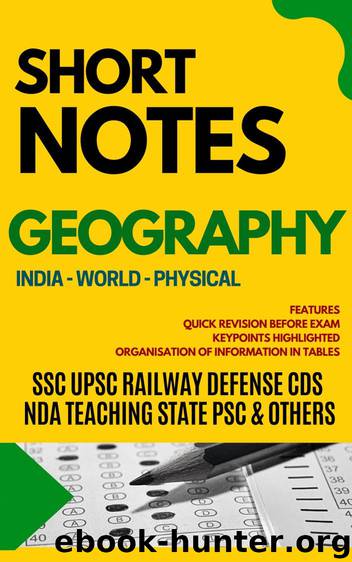SHORT NOTES GEOGRAPHY: GENERAL KNOWLEDGE SERIES: FOR ALL COMPETITIVE EXAMS SSC UPSC CDS RAILWAY STATE PSCs TET ARMY NAVY POLICE TEACHING CLERK by Publishers Rainbow

Author:Publishers, Rainbow [Publishers, Rainbow]
Language: eng
Format: epub
Published: 2019-02-07T16:00:00+00:00
The Solar System
➤ The solar system consists of the Sun, the eight planets and their satellites and various other smaller heavenly bodies such as asteroids, comets and meteors.
The Sun
➤ The sun is a star . It is the star around which the earth and other planets revolve. It is the nearest star to the earth.
➤ Light travelling at a speed of 300,000 km. per second, takes about 8 minutes to reach us from the Sun.
➤ The next nearest star to earth is “Alpha Centuari” .
➤ The Sun is mainly composed of hydrogen. The glowing surface of the Sun which we see is called ‘Photosphere’.
➤ Above the photospheres is the red cloud ‘Chromosphere’. Beyond the chromospheres is the ‘Corona’, which is visible during eclipses.
➤ The temperature of the photospheres is about 6000°C, that of the chromosphere about 32400°C, and that of the corona about 2,700,000°C.
➤ The core of the Sun has a temperature about 15 million degrees C.
➤ The dark lines in the corona are called ‘Fraunhofer lines’. The emission of hydrogen in all directions is called ‘Prominences ’ .
➤ Sometimes they roll out of the atmosphere to be seen as ‘Solar flares’.
➤ The outward stream of protons flowing out from the corona are called ‘Solar winds’, which is made up of plasma.
➤ The earth’s Magnetosphere or Van Allen belts, as they were earlier called, acts as a shield and deflects the Solar winds.
➤ ‘Sun spots’ are dark patches notched on the surface of the Sun. They appear dark because they are cooler i.e. they have a temperature of about 1500°C .
The Moon
➤ The Moon’s diameter is onefourth of Earth diameter.
➤ Circumference : 11000 km. approximately.
➤ Gravitational Pull in 1/6th of the Earth.
➤ Its orbit around the earth in elliptical orbit.
➤ Distance between the Earth and the Moon is 3,82500 km. approx. (According to NASA)
➤ The distance varies because it revolves around the Earth is an elliptical orbit.
➤ At Perigee the point at which the moon is closest to the Earth, the distance is approximately 3,60000 km .
➤ At Epogee the point at which the moon is farthest to the earth, the distance is approximately 4,05,000 km . (According to NASA).
➤ The Moon is 1/4th size of the Earth.
➤ The Moon take 27 day, 7 hrs, 43 min. and 11.47 sec. to complete one revolution around the Earth.
➤ The Moon in the only satellite of the Earth.
➤ The Moon rotates on its axis in exactly the same time as that of its revolution. That's why we see only one part of the moon.
➤ We can see only 59% of its surface.
➤ There is no atmosphere on the moon.
➤ The moon has no light of its own. It reflects sun light.
➤ The reflected light by the moon reaches on the Earth in 1.3 seconds .
➤ It has a low albedo (reflection).
➤ It reflects only 7% and the rest is absorbed by venus.
➤ Neil Armstrong and Aldrin reached the moon on 21, July 1969 . Through Apollo × 1.
➤ Landing spot is called ‘sea of tranquility’
➤ The black spot on the moon is called 'sea of tranquility.
Download
This site does not store any files on its server. We only index and link to content provided by other sites. Please contact the content providers to delete copyright contents if any and email us, we'll remove relevant links or contents immediately.
The Art of Coaching Workbook by Elena Aguilar(50989)
Trainspotting by Irvine Welsh(21519)
The Secret History by Donna Tartt(18849)
Twilight of the Idols With the Antichrist and Ecce Homo by Friedrich Nietzsche(18503)
All the Missing Girls by Megan Miranda(15579)
Cat's cradle by Kurt Vonnegut(15186)
Ready Player One by Cline Ernest(14525)
Talking to Strangers by Malcolm Gladwell(13222)
Fangirl by Rainbow Rowell(9097)
The remains of the day by Kazuo Ishiguro(8825)
The Compound Effect by Darren Hardy(8810)
Thirteen Reasons Why by Jay Asher(8796)
Tools of Titans by Timothy Ferriss(8218)
Periodization Training for Sports by Tudor Bompa(8170)
Wonder by R. J. Palacio(8010)
The Lover by Duras Marguerite(7830)
A Court of Wings and Ruin by Sarah J. Maas(7652)
Change Your Questions, Change Your Life by Marilee Adams(7635)
The Complete Stick Figure Physics Tutorials by Allen Sarah(7307)
